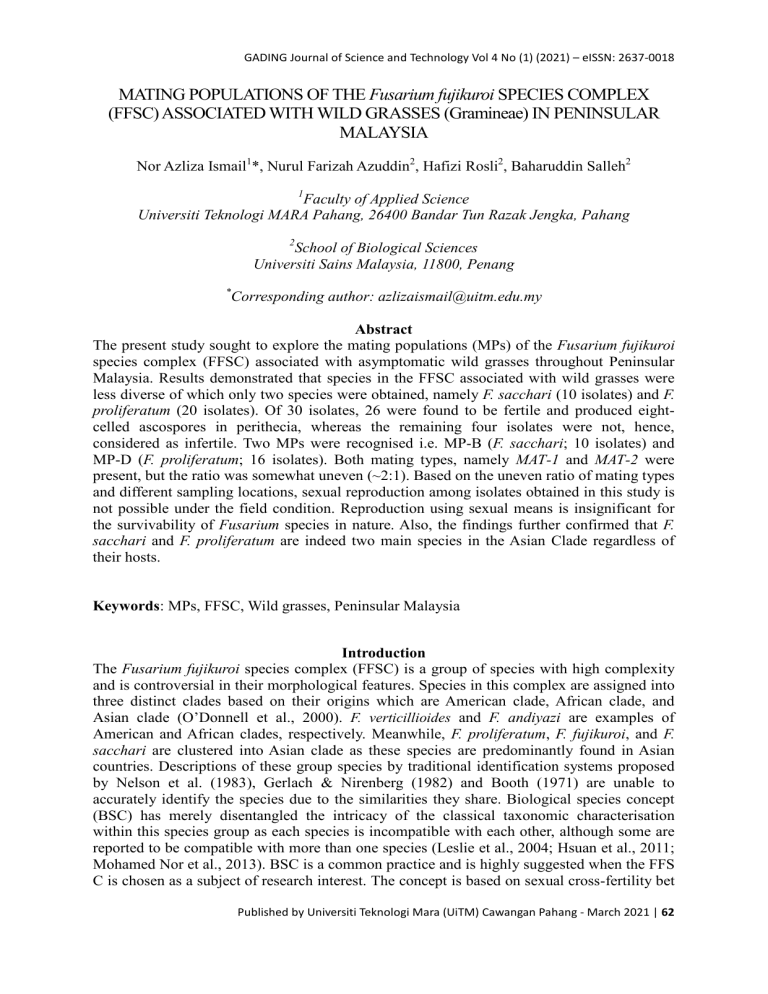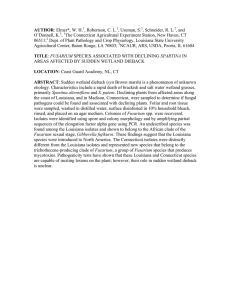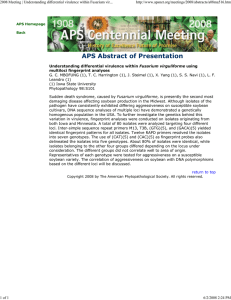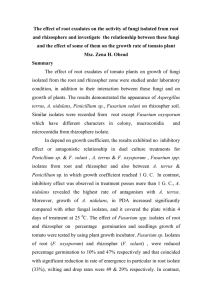MATING POPULATIONS OF THE Fusariumfujikuroi SPECIES COMPLEX (FFSC) ASSOCIATED WITH WILD GRASSES (Gramineae) IN PENINSULAR MALAYSIA
advertisement

GADING Journal of Science and Technology Vol 4 No (1) (2021) – eISSN: 2637-0018 MATING POPULATIONS OF THE Fusarium fujikuroi SPECIES COMPLEX (FFSC) ASSOCIATED WITH WILD GRASSES (Gramineae) IN PENINSULAR MALAYSIA Nor Azliza Ismail1*, Nurul Farizah Azuddin2, Hafizi Rosli2, Baharuddin Salleh2 1 Faculty of Applied Science Universiti Teknologi MARA Pahang, 26400 Bandar Tun Razak Jengka, Pahang 2 School of Biological Sciences Universiti Sains Malaysia, 11800, Penang * Corresponding author: azlizaismail@uitm.edu.my Abstract The present study sought to explore the mating populations (MPs) of the Fusarium fujikuroi species complex (FFSC) associated with asymptomatic wild grasses throughout Peninsular Malaysia. Results demonstrated that species in the FFSC associated with wild grasses were less diverse of which only two species were obtained, namely F. sacchari (10 isolates) and F. proliferatum (20 isolates). Of 30 isolates, 26 were found to be fertile and produced eightcelled ascospores in perithecia, whereas the remaining four isolates were not, hence, considered as infertile. Two MPs were recognised i.e. MP-B (F. sacchari; 10 isolates) and MP-D (F. proliferatum; 16 isolates). Both mating types, namely MAT-1 and MAT-2 were present, but the ratio was somewhat uneven (~2:1). Based on the uneven ratio of mating types and different sampling locations, sexual reproduction among isolates obtained in this study is not possible under the field condition. Reproduction using sexual means is insignificant for the survivability of Fusarium species in nature. Also, the findings further confirmed that F. sacchari and F. proliferatum are indeed two main species in the Asian Clade regardless of their hosts. Keywords: MPs, FFSC, Wild grasses, Peninsular Malaysia Introduction The Fusarium fujikuroi species complex (FFSC) is a group of species with high complexity and is controversial in their morphological features. Species in this complex are assigned into three distinct clades based on their origins which are American clade, African clade, and Asian clade (O’Donnell et al., 2000). F. verticillioides and F. andiyazi are examples of American and African clades, respectively. Meanwhile, F. proliferatum, F. fujikuroi, and F. sacchari are clustered into Asian clade as these species are predominantly found in Asian countries. Descriptions of these group species by traditional identification systems proposed by Nelson et al. (1983), Gerlach & Nirenberg (1982) and Booth (1971) are unable to accurately identify the species due to the similarities they share. Biological species concept (BSC) has merely disentangled the intricacy of the classical taxonomic characterisation within this species group as each species is incompatible with each other, although some are reported to be compatible with more than one species (Leslie et al., 2004; Hsuan et al., 2011; Mohamed Nor et al., 2013). BSC is a common practice and is highly suggested when the FFS C is chosen as a subject of research interest. The concept is based on sexual cross-fertility bet Published by Universiti Teknologi Mara (UiTM) Cawangan Pahang - March 2021 | 62 GADING Journal of Science and Technology Vol 4 No (1) (2021) – eISSN: 2637-0018 ween fungal strains of which the progenies need to be viable and fertile (Perkins, 1994). The species is then considered as genetically distinct biological species and is placed under differe nt groups known as mating populations (MPs). In agricultural settings, MP-A (F. verticillioides), MP-D (F. proliferatum), and MP-F (F. thapsinum) are the most frequently recovered MPs worldwide (Mohamed Nor et al., 2019; Jabłońska et al., 2020; Jiang et al., 2021). Earlier reports on the FFSC and their MPs in Southeast Asia (SEA) found that MP-A (F. verticillioides) is the common MP isolated from maize (Summerell et al., 1998; Cumagun, 2007). In Malaysia, five MPs have been compiled, namely MP-A (F. verticillioides), MP-B (F. sacchari), MP-C (F. fujikuroi), MP-D (F. proliferatum) and MP-E (F. subglutinans). These MPs are associated with three local agricultural hosts which are rice, sugarcane, and maize (Hsuan et al., 2011). Adding to this, Mohamed Nor et al. (2013) found 29 isolates from mango were MP-D (F. proliferatum). Masratul Hawa et al. (2013) further reported 83 isolates from dragon fruit were also MP-D (F. proliferatum). Recently, F. proliferatum (MP-D) was also reported from corn ear rot together with F. verticillioides (MP-A) by Mohd Zainudin et al. (2017). Thus, it can be concluded that sexual reproduction could occur, and MP-D (F. proliferatum) is the most commonly found species recovered from agricultural hosts. Based on the above-mentioned literature, the teleomorph phase of the FFSC from local agricultural hosts is well-known with numerous reports available. However, in Malaysia and other Asian countries, reports on the FFSC and its teleomorph recovered from the natural ecosystem such as wild grasses are unknown. Grasses surpass any other flowering plants in seeds distribution due to wind-pollination, fertility in seed production, simple fruit dispersal devices, vegetative spread by tillers and rhizomes, regeneration of parts from growing points, and regeneration of whole plants from buds. These favourable mechanisms may have caused some grass species to appear to be alternate hosts for several pathogens (Fulcher et al., 2019; Seifollahi et al., 2020; Maia et al., 2020). This present work assumed that the FFSC recovered from the Asian wild grasses (Gramineae) are also able to sexually reproduce and the grasses might have the potential to be the alternate hosts for species in this complex. This work also provides extended information related to the biological diversity of the FFSC recovered from tropical regions, specifically in Malaysia and generally in Southeast Asia (SEA). Materials and Methods Fusarium isolates A total of 30 isolates of the morphologically identified FFSC consisted of F. proliferatum (20 isolates) and F. sacchari (10 isolates) were evaluated for their sexual compatibility by conducting the mating test with the standard tester strains. The species were isolated from wild asymptomatic grasses randomly collected throughout Peninsular Malaysia. All isolates are listed in Table 1. Sexual crosses Sexual crosses were conducted according to a procedure by Klittich and Leslie (1992). Field isolates and standard tester strains were grown on PDA for 7 days prior to the crossing procedures. The standard tester strains, F. sacchari (B3852 and B3853) and F. proliferatum (D4853 and D4854) were provided by Kansas State University (KSU). Field isolates served as male parents were grown on complete medium (CM) slant agar (CM; 6 - 8 ml of medium in a 16 x 150 mm test tube), while standard tester strains served as female parents were grown on thick carrot agar (CA) in disposable petri dishes (60 x 15 mm). Both male and female parents were grown on the same day. After seven days, 1 ml of Tween 60 solution (0.25%) was poured into the tube and gently shaken to obtain the conidial suspension. The suspension was then spread evenly on the CA plates using a sterile spreader. Fertilised Published by Universiti Teknologi Mara (UiTM) Cawangan Pahang - March 2021 | 63 GADING Journal of Science and Technology Vol 4 No (1) (2021) – eISSN: 2637-0018 cultures were incubated at 25ºC under cool-white and near UV fluorescent light bulbs for six weeks. Crosses were considered successful after perithecia started oozing viable ascospores on the incubated cultures. Perithecia were observed in situ using a compound microscope (FESEM Leo Supra model 50 VP Carl-Zeiss SMT), while asci and ascospores were observed under a light microscope (Olympus model BX-50F4). Images of perithecia, asci and ascospores were captured using a camera (JVC model FY-F55BE) with an image proanalyser attached to both cameras. Results and discussion A total of 16 F. proliferatum and 10 F. sacchari isolates were male fertile and produced perithecia. The remaining four isolates of F. proliferatum failed to produce perithecia and were assumed infertile. Matured perithecia appeared on CA after 3 to 4 weeks of fertilisation. Perithecia were superficial, solitary to aggregate in groups, obovoid, wart-like appearance, and blue-black in colour (Figure 1A). Asci were fusiform, thin-walled, non-pigmented, and generally contained eight ascospores (Figure 1B, 1C and 1D). The ascospores were 2-celled with 1-septate, rounded at both ends and slightly constricted at the septum (Figure 1E, 1F and 1G). High fertility among F. proliferatum and F. sacchari was previously reported by Petrovic et al. (2013) and Nurul Faziha et al. (2017). Both species are generalists, being recovered from a broad range of agricultural hosts (Leslie & Summerell, 2006). Among 16 fertile F. proliferatum isolates, 10 isolates carried MAT-1 and the other six carried MAT-2, making MAT-1: MAT-2 ratio obtained was ~2:1. Meanwhile, all 10 F. sacchari isolates carried MAT-1. The dissimilarity of the mating type idiomorphs ratio with a larger number of MAT-1 than MAT-2 among field isolates has been reported by many authors (Jurado et al., 2010; Masratul Hawa et al., 2013; Qiu et al., 2015). Theoretically, the maximum effective reproductive strategy occurs when the ratio of the mating type idiomorphs are 1:1 (Britz et al., 1998). In most cases, the ratio was generally different from the expected 1:1 ratio. It further provides a clue as to why sexual reproduction is uncommon in the field. The finding correlates well with Venturini et al. (2011) where they found the possibility of sexual reproduction to occur was obscured due to the predominance of one mating type. Sexual reproduction may also occur in the field if both mating type alleles (MAT-1 and MAT-2) present in the same field and seed lots (Leslie, 1995). From the allele distribution in this study herein, sexual reproduction in the field was impossible as isolates that carried different alleles were recovered from different sampling locations (Table 1). The anamorph of F. proliferatum was morphologically inseparable with that of F. fujikuroi. However, both species were successfully separated using the mating test as no field isolates of F. proliferatum were observed to cross fertile with MP-C (F. fujikuroi) tester strains. Hence, it can be assumed that a complete barrier exists between F. proliferatum isolates recovered in this study with MP-C (F. fujikuroi) tester strains. Isolates of F. sacchari also showed no sexual interbreed with MP-E (F. subglutinans) tester strains. The MAT-1 and MAT-2 alleles were responsible for recombination (de Oliveira Rocha et al., 2011) and specific in each heterothallic Fusarium species. Therefore, the identification of Fusarium species can be done by using these alleles through sexual crosses (Leslie & Summerell, 2006). Published by Universiti Teknologi Mara (UiTM) Cawangan Pahang - March 2021 | 64 GADING Journal of Science and Technology Vol 4 No (1) (2021) – eISSN: 2637-0018 Table 1 FFSC recovered from wild grasses throughout Peninsular Malaysia and their MPs a Fusarium speciesa Isolateb Locationc F. sacchari (10 isolates) J3527& J3531& M3554& P3575& P3588& P3600& K3619& K3624& T3671& C3852& Skudai, JOHOR Skudai, JOHOR St. John, MELAKA Seberang Perai, P. PINANG Bukit Relau, P. PINANG Sungai Pinang, P. PINANG Padang Terap, KEDAH Padang Terap, KEDAH Kemaman, TERENGGANU Cameron Highlands, PAHANG Mating type gened MAT-1/2 1 1 1 1 1 1 1 1 1 1 F. proliferatum (20 isolates) D3474& C3488& T3505& T3509& J3518& M3542& P3586& P3594& P3599& P3606& P3607& P3611& K3620& T3688& C5099& C5362& C5538& C5980& C6662& C6663& Pasir Puteh, KELANTAN Cameron Highlands, PAHANG Kemaman, TERENGGANU Kemaman, TERENGGANU Skudai, JOHOR St. John, MELAKA Bukit Relau, P. PINANG Sg. Burong, P. PINANG Sg. Pinang, P. PINANG Teluk Bahang, P. PINANG Teluk Bahang, P. PINANG Seberang Perai, P. PINANG Padang Terap, KEDAH Kemaman, TERENGGANU Genting Highlands, PAHANG Genting Highlands, PAHANG Genting Highlands, PAHANG Genting Highlands, PAHANG Cameron Highlands, PAHANG Cameron Highlands, PAHANG 1 1 1 1 1 1 2 1 1 1 2 2 1 2 1 1 1 1 2 2 Fusarium species morphologically identified using Leslie & Summerell (2006) Isolates coding number according to Fusarium Culture Collection Unit, Universiti Sains Malaysia c Sampling location throughout Peninsular Malaysia d Mating types based on the mating test with the standard tester strains provided by KSU e Assigned MPs after sexual crosses with the standard tester strains provided by KSU Mating Populatione MP-B MP-B MP-B MP-B MP-B MP-B MP-B MP-B MP-B MP-B MP-D MP-D MP-D MP-D MP-D MP-D MP-D MP-D MP-D MP-D MP-D MP-D MP-D MP-D NF NF NF NF MP-D MP-D b Published by Universiti Teknologi Mara (UiTM) Cawangan Pahang - March 2021 | 65 GADING Journal of Science and Technology Vol 4 No (1) (2021) – eISSN: 2637-0018 Figure 1 Morphological features of the FFSC after sexual crosses. A. Blue-black perithecia in situ on CA surface. B-D. A bunch of asci bearing matured ascospores. E-G. 2-celled ascospores discharged from the ascus Published by Universiti Teknologi Mara (UiTM) Cawangan Pahang - March 2021 | 66 GADING Journal of Science and Technology Vol 4 No (1) (2021) – eISSN: 2637-0018 A molecular approach has been widely used by researchers worldwide of which they detect specific genes, namely MAT1-1 and MAT1-2 responsible for mating type alleles in the FFSC (Mohamed Nor et al., 2019; Maia et al., 2020; Jiang et al., 2021). The mating type is generally determined through PCR amplification by using the primer sets comprising Gfmat1a and Gfmat1b for MAT1-1, and Gfmat2c and Gfmat2d for MAT1-2. Although sexual crosses are time-consuming and cumbersome, the techniques, however, are reliably useful if molecular techniques involving high-end apparatus and costly chemicals are not available. F. proliferatum and F. sacchari were believed to have evolved in New Guinea and were placed in Asian clade (O’Donnell et al., 1998; Petrovic et al., 2013). The close geological separation of Papua New Guinea from Malaysia suggests that these species may have a long co-evolutionary history with Malaysian grasses as well as other non-domesticated plants. Wild grasses may serve as alternate hosts and reservoirs of these fungal pathogens. Maia et al. (2020) reported that F. gigantea was found to be pathogenic to maize although the species is known to be an endophyte species of a common forage grass, Panicum maximum. Based on the present study, the potential alternate host is Dactyloctenium aegyptium, a wild grass grown at sugarcane plantations in Padang Terap, Kedah where F. sacchari was recovered from (data not shown). From different types of grasses and numerous sampling locations, this study gives a preliminary assumption that among the FFSC, F. proliferatum and F. sacchari are the most commonly isolated species from wild grasses. To the best of our knowledge, this study also offers the first information regarding the FFSC and their MPs recovered from wild grasses in Malaysia as well as in SEA. Larger samples are indeed required to better understand the diversity of these species and their population structures in the natural ecosystem. Conclusion Two MPs, namely MP-B and MP-D were recovered from this study. Both mating type alleles (MAT-1 and MAT-2) with unequal frequencies were observed and from the ratio of mating type alleles of both species, the occurrence of sexual reproduction in the field was not possible. In terms of species distribution, F. sacchari (MP-B) and F. proliferatum (MP-D) were the main species recovered, supporting the earlier findings that these species were from Asia. Regardless of its hosts, F. proliferatum (MP-D) is indeed the most commonly found FFSC in Malaysia. All isolates were presumably endophytes and/or saprophytes since no visible symptoms were observed on the grass samples. . Acknowledgement The project was funded by Fundamental Research Grant Scheme (FRGS, PBIOLOGY/6711157). The authors are thankful to Mr. Kamarudin Mohd Maidin for his technical assistance in the field during grass sample collection. Conflict of interests The authors declare that there are no conflicts of interests concerning the publication of this paper. References Booth, C. (1971). The genus Fusarium. Commonwealth Mycological Institute, Kew, England. 237. Britz, H., Wingfield, M. J., Coutinho, T. A., Marasas, W. F. O., & Leslie, J. F. (1998). Female fertility and mating type distribution in a South African population of Fusarium subglutinans Published by Universiti Teknologi Mara (UiTM) Cawangan Pahang - March 2021 | 67 GADING Journal of Science and Technology Vol 4 No (1) (2021) – eISSN: 2637-0018 f. sp. pini. Applied and Environmental 10.1128/AEM.64.6.2094-2095.1998 Microbiology, 64(6), 2094-2095. Cumagun, C. J. R. (2007). Population genetic analysis of plant pathogenic fungi with emphasis on Fusarium species. The Philippine Agricultural Scientist, 90(3), 244-256. de Oliveira Rocha, L., Reis, G. M., Da Silva, V. N., Braghini, R., Teixeira, M. M. G., & Corrêa, B. (2011). Molecular characterization and fumonisin production by Fusarium verticillioides isolated from corn grains of different geographic origins in Brazil. International Journal of Food Microbiology, 145(1), 9-21. https://doi.org/10.1016/j.ijfoodmicro.2010.11.001 Fulcher, M. R., Garcia, J. P., Damann, K. C. M., & Bergstrom, G. C. (2019). Variable interactions between non-cereal grasses and Fusarium graminearum. Canadian Journal of Plant Pathology, 41(3), 450–456. https://doi.org/10.1080/07060661.2019.1605540 Gerlach, W., Nirenberg, H., Eckart, I., Rummland, I., & Schwarz, R. (1982). The genus Fusarium: a pictorial atlas (Vol. 209). Berlin: Kommissionsverlag P. Parey. Hsuan, H. M., Salleh, B., & Zakaria, L. (2011). Molecular identification of Fusarium species in Gibberella fujikuroi species complex from rice, sugarcane, and maize from Peninsular Malaysia. International Journal of Molecular Sciences, 12(10), 6722-6732. https://doi.org/10.3390/ijms12106722 Jiang, H., Wu, N., Jin, S., Ahmed, T., Wang, H., Li, B., . . . Zhang, J. Z. (2021). Identification of rice seed-derived Fusarium spp. and development of LAMP assay against Fusarium fujikuroi. Pathogens, 10(1), 1-22. https://doi.org/10.3390/pathogens10010001 Jabłońska, E., Wiśniewska, M., Marcinkowski, P., Grygoruk, M., Walton, C. R., Zak, D., . . . Kotowski, W. (2020). Catchment-scale analysis reveals high cost-effectiveness of wetland buffer zones as a remedy to non-point nutrient pollution in North-Eastern Poland. Water, 12(3), 629-650. https://doi.org/10.3390/w12030629 Jurado, M., Marín, P., Callejas, C., Moretti, A., Vazquez, C., & González-Jaén, M. T. (2010). Genetic variability and fumonisin production by Fusarium proliferatum. Food microbiology, 27(1), 50-57. https://doi.org/10.1016/j.fm.2009.08.001 Klittich, C. J., & Leslie, J. F. (1992). Identification of a second mating population within the Fusarium moniliforme anamorph of Gibberella fujikuroi. Mycologia, 84(4), 541-547. https://doi.org/10.1080/00275514.1992.12026175 Leslie, J. F. (1995). Gibberella fujikuroi: available populations and variable traits. Canadian Journal of Botany, 73(S1), 282-291. https://doi.org/10.1139/b95-258 Leslie, J. F., & Summerell, B. A. (2006). The Laboratory Fusarium. Manual. Blackwell Publishing Ltd, UK. 388 pp. Leslie, J. F., Zeller, K. A., Logrieco, A., Mule, G., Moretti, A., & Ritieni, A. (2004). Species diversity of and toxin production by Gibberella fujikuroi species complex strains isolated from native prairie grasses in Kansas. Applied and Environmental Microbiology, 70(4), 2254Published by Universiti Teknologi Mara (UiTM) Cawangan Pahang - March 2021 | 68 GADING Journal of Science and Technology Vol 4 No (1) (2021) – eISSN: 2637-0018 2262. 10.1128/AEM.70.4.2254-2262.2004 Maia, N. C., Melo, M. P., & Guimarães, S. S. C. (2020). Panicum maximum as a reservoir of a potential maize pathogen. European Journal of Plant Pathology, 159, 95–104. https://doi.org/10.1007/s10658-020-02145-z Masratul Hawa, M., Salleh, B., & Latiffah, Z. (2013). Characterization and pathogenicity of Fusarium proliferatum causing stem rot of Hylocereus polyrhizus in Malaysia. Annals of Applied Biology, 163(2), 269-280. https://doi.org/10.1111/aab.12057 Mohamed Nor, N. M. I., Salleh, B., & Leslie, J. F. (2013). Fusarium species associated with mango malformation in Peninsular Malaysia. Journal of Phytopathology, 161(9), 617-624. https://doi.org/10.1111/jph.12109 Mohamed Nor, N. M. I., Salleh, B., & Leslie, J. F. (2019). Fusarium species from sorghum in Thailand. Plant Pathology Journal, 35(4), 301–312. https://doi.org/10.5423/PPJ.OA.03.2019.0049 Mohd Zainudin, N. A. I., Hamzah, F. A., Kusai, N. A., Zambri, N. S., & Salleh, S. (2017). Characterization and pathogenicity of Fusarium proliferatum and Fusarium verticillioides, causal agents of Fusarium ear rot of corn. Turkish Journal of Biology, 41(1), 220-230. https://doi.org/10.3906/biy-1606-25 Nelson, P. E., Toussoun, T. A., & Marasas, W. F. O. (1983). Fusarium species: an illustrated manual for identification. The Pennsylvania State University Press. University Park and London. 172 pp. Nurul Faziha, I., Masratul Hawa, M. Mohamed Nor, N. M. I., & Latiffah, Z. (2017). Characterization of Fusarium spp. associated with pineapple fruit rot and leaf spot in Peninsular Malaysia. Journal of Phytopathology, 165(11-12), 718-726. https://doi.org/10.1111/jph.12611 O'Donnell, K., Cigelnik, E., & Nirenberg, H. I. (1998). Molecular systematics and phylogeography of the Gibberella fujikuroi species complex. Mycologia, 90(3), 465-493. https://doi.org/10.1080/00275514.1998.12026933 O’Donnell, K., Nirenberg, H. I., Aoki, T., & Cigelnik, E. (2000). A multigene phylogeny of the Gibberella fujikuroi species complex: Detection of additional phylogenetically distinct species. Mycoscience, 41(1), 61-78. https://doi.org/10.1007/BF02464387 Perkins D. D. (1994). How should the interfertility of interspecies crosses be designated? Mycologia, 86(6), 758-761. https://doi.org/10.1080/00275514.1994.12026480 Petrovic, T., Burgess, L. W., Cowie, I., Warren, R. A., & Harvey, P. R. (2013). Diversity and fertility of Fusarium sacchari from wild rice (Oryza australiensis) in Northern Australia, and pathogenicity tests with wild rice, rice, sorghum and maize. European Journal of Plant Pathology, 136(4), 773-788. https://doi.org/10.1007/s10658-013-0206-7 Qiu, J., Xu, J., Dong, F., Yin, X., & Shi, J. (2015). Isolation and characterization of Fusarium verticillioides from maize in eastern China. European Journal of Plant Pathology, 142(4), Published by Universiti Teknologi Mara (UiTM) Cawangan Pahang - March 2021 | 69 GADING Journal of Science and Technology Vol 4 No (1) (2021) – eISSN: 2637-0018 791-800. https://doi.org/10.1007/s10658-015-0652-5 Seifollahi, E., Sharifnabi, B., Javan-Nikkhah, M., & Linde, C. C. (2020). Scald on gramineous hosts in Iran and their potential threat to cultivated barley. Mycological Progress, 19(3), 223–233. https://doi.org/10.1007/s11557-019-01553-8 Summerell, B. A., Burgess, L. W., Bullock, S., Backhouse, D., & Tri, N. D. (1998). Occurrence of perithecia of Gibberella fujikuroi mating population A (Fusarium moniliforme) on maize stubble in northern Vietnam. Mycologia, 90(5), 890-895. https://doi.org/10.1080/00275514.1998.12026982 Venturini, G., Assante, G., & Vercesi, A. (2011). Fusarium verticillioides contamination patterns in Northern Italian maize during the growing season. Phytopathologia Mediterranea, 50(1), 110-120. https://www.jstor.org/stable/26458683 Published by Universiti Teknologi Mara (UiTM) Cawangan Pahang - March 2021 | 70







